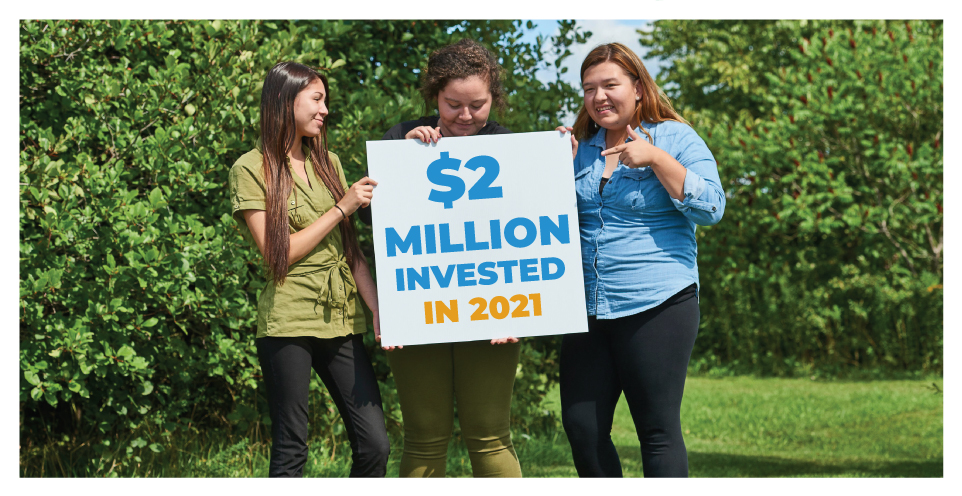Vancity Community Investment Bank (VCIB) hosted a webinar on February 3, titled “Building Partnerships for Indigenous Clean Energy”. That dynamic discussion left us craving more, knowing there’s still so much to learn from our panel participants. Here, Matt Jamieson, SNGRDC President and CEO, shares more about Six Nations’ journey from being a clean energy participant to being a clean energy developer.
___
With nearly 1,400 megawatts of renewable energy capacity in operation or under development, the Six Nations of the Grand River Development Corporation (SNGRDC) is past the point where it has to push for a seat at the table when major economic decisions are being made.
“I’m pleased to say it’s our boardroom now,” said SNGRDC President and CEO, Matt Jamieson. It’s taken more than a decade, but the community now owns and initiates its own renewable energy and energy storage projects, then cycles the revenue back into community services and well-being.
The community’s latest project was a deal with Vancity Community Investment Bank (VCIB) to refinance the Niagara Region Wind Farm, the second-largest in Ontario.
Community Autonomy by 2030
The rapid growth of SNGRDC’s renewable energy portfolio is gaining recognition as a monumental achievement in its own right. But there’s a far bigger purpose behind the projects. Autonomy 150 by 2030 is the title of the development corporation’s medium-term strategic goal: to generate $150 million in annual economic impact by the end of this decade.
“We believe that by being successful in that pursuit, our future leaders will have the ability to be totally autonomous of any outside influences or funding,” Jamieson said. That financial stability will enable the community to “make independent decisions that are grounded in our nationhood and not influenced by dependency on any third party.”
For years, renewable energy proponents have tried to pitch projects by pointing to jobs, business opportunities, and better health as secondary benefits that communities can expect when they decarbonize their energy supplies. Yet, for the SNGRDC, these so-called secondary benefits are just the start.
“These co-benefits are just as important as the sustainable outcomes our investments create,” Jamieson said. “We don’t get involved in industries unless there’s a positive impact on the environment, on our future. Everything we do as a society is qualified through seven-generational thinking. If it’s not good today, it’s certainly not going to be good seven generations down the road.”
Unlocking the Value
That line of thought leads to a strategy that seeks to add value streams at every stage of a project.
As SNGRDC has matured as a company, “we actively take equity in these projects,” Jamieson said, with a 51% share becoming the new math of any investment the development corporation takes on. It also means keeping the benefits of a major project closer to home through job creation and local spending with community-based enterprises.
“Not only are we an investor. We’re the constructor of these projects,” he explained. “It creates tremendous economic impact, it puts people to work, it builds pride in the community, and that creates more opportunities to partner and grow.”
Meanwhile, financial returns from the projects have supported more than $14 million in community care and infrastructure investments since 2016.
Next up, SNGRDC is co-developing a 250-megawatt, 1,000 megawatt-hour battery storage facility that will be Canada’s biggest when it’s complete, delivering 4.1 million tonnes of greenhouse gas reductions. Strategic investments such as this “will finally unlock the true value of renewable energy, which will lead to future public policy that clearly embraces more renewables procurement,” Jamieson said.
The Community Takes Charge
SNGRDC’s success, with its $2.4 billion worth of development experience, is changing the dynamics of community energy investment.
“We have developers calling us every day, many need us more than we need them, and that’s a refreshing change,” Jamieson said. “It’s a paradigm shift from the past. We control the boardroom, so if companies don’t share our values and have the same sustainable focus, we simply don’t let them in.”
Businesses that approach us have a “responsibility to be authentic,” Jamieson explained. They have to listen and learn about the aspects of a new venture that matter most to the community. “Maybe it’s not about a slice of the profits. Maybe it’s to help build water infrastructure for the community. It may be a narrative that activates other opportunities.”
To get that understanding, “you must have a relationship and relationships take time. Given our past experience in this country, you have to earn trust, and that takes time, too.”
But that’s starting to happen. He cited Aecon, a large infrastructure firm that “saw the writing on the wall over a decade ago,” and which has become a valued partner that collaborates on projects throughout the region. VCIB showed its commitment with the refinancing deal that brought the community $400,000 per year in additional profits from the Niagara Region Wind Farm.
VCIB “really proved to be a flexible lending partner that understood the situation we were in at the time,” he recalled. “We were seeking a banking partner that could help us optimize the economic return for our community and they really latched onto that goal. They were very flexible in working with us to arrive at the outcome we were pursuing.”
In the end, “the impact will be real, and we couldn’t have done it without VCIB.”
__
Eager to learn more about the role that values-based partnerships and cross-sector collaboration can play in helping communities overcome challenges, build capacity, and reap the benefits of the clean energy transition? Read Terri Lynn Morrison’s guest post “True partnership is key to Indigenous clean energy success” and watch the February 3 webinar video below.


